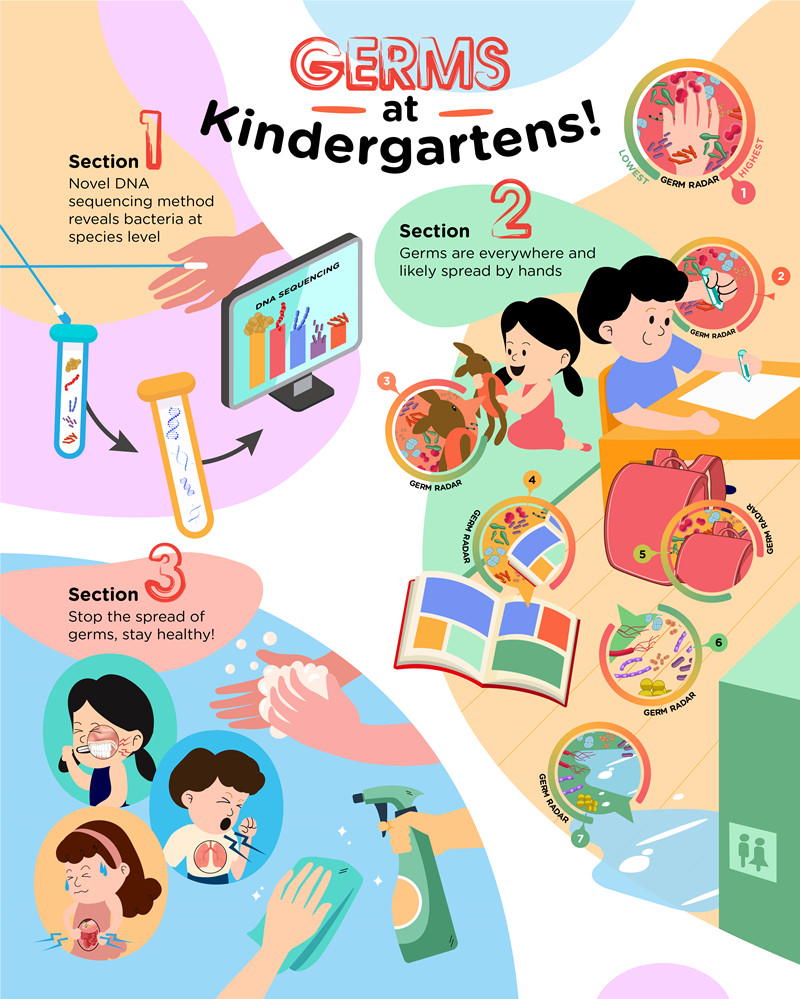Preschool Petri Dish: Maintenance of Good Personal & Environmental Hygiene to Better Protect Children’s Health
In a first-of-its-kind analysis of two kindergartens in China, researchers determined the proportion and species of microbes across a variety of surfaces and children’s palms. The most active sites, and likely routes of transmission, were the kids’ hands — which the researchers found could possibly harbor more pathogens than the bathroom floor.
The results were published on March 28 in Frontiers in Microbiology.
"Young children typically spend up to eight hours daily at the kindergarten, surrounded by indoor microbiomes that can significantly impact their short-term and long-term health," said first author Tze Hau Lam, senior scientist at Procter & Gamble Singapore Innovation Center.
While previous studies have demonstrated the presence of common microbes in childcare and school settings, typical analysis approaches could not reliably reveal every species.
"Unlike human microbiomes, samples collected from the built environment are often of low biomass and can be heavily degraded, so applying metagenomic sequencing techniques on such samples has been difficult," said co-corresponding author LIU Jiquan, principal scientist at Procter & Gamble Singapore Innovation Center.
To identify the species in small, degraded samples, the researchers employed 2bRAD-M, a metagenome reduction sequencing approach. It involves a similar process to metagenomics approach, in which DNA is extracted and amplified, but it uses an extensive computer database to identify specific tags in the DNA sequences. Relevant, species-level genomic information is separated from the junk genetic material that could lead to confusion between species or even bias.
"This approach allows for the profiling of low-biomass microbiomes, revealing not just the prevalence of pathogens but also the possible microbial flow and interactions among surfaces in the kindergarten," said co-corresponding author XU Jian, head of Single-Cell Center at the Qingdao Institute of Bioenergy and Bioprocess Technology (QIBEBT), Chinese Academy of Sciences (CAS).
XU noted that this approach does not indicate risk of infection. "The likelihood of infection largely depends on the quantity of exposure, virulence and activity, information which might be challenging to obtain from this data."
In January of 2020, the researchers collected 114 samples from seven surfaces and children’s palms in two kindergartens — which include children from three to six years old in China — in two different residential districts in the same province. They found that dominant species on hand-touched objects were more associated with the human microbiota, while those on the floor were closer related to the environment.
"In both kindergartens, samples collected from the floor were observed to form a distinctive cluster separate from samples collected from hand-touched objects, suggesting that the microbiomes between these two types of surfaces are distinct," said Dillon Chew, who also noted that each kindergarten had its own distinct microbiome composition. "Together, these observations suggest that the microbial communities of each site are heavily shaped by interaction with the environment and by human behaviors."
The researchers also found that children’s palms had the highest number of pathogenic species, while floor samples held the least, and toys had twice as many as other surfaces. The 34 species found on the children’s hands are mostly associated with respiratory and gastro-intestinal infections.
"The highly touched surfaces are common contact hotspots, most likely serving as potential intermediaries for cross-transmission to and from children’s palms," LIU Jiquan said. "Overall, this suggests that children’s hands can possibly harbor more potentially pathogenic bacterial species than those surfaces conventionally considered 'dirty,' such as the toilet floor. This highlights those surfaces where higher standards of sanitation are needed for proper hygiene control in kindergartens."

Contact:
CHENG Jing
Qingdao Institute of Bioenergy and Bioprocess Technology, Chinese Academy of Sciences